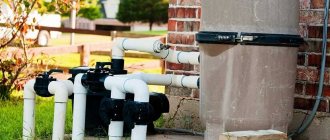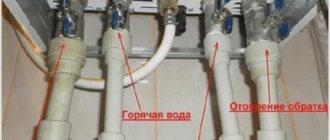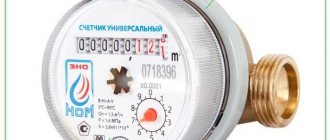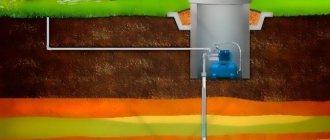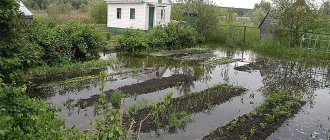Has the water in your well become dirty and its smell leaves much to be desired? Agree, such water is not only unpleasant to use as drinking water, but also very dangerous. After all, the microorganisms it contains can lead to various diseases.
Are you planning to disinfect a source, but don’t know how to do it correctly? We will help you understand the intricacies of this process and tell you what tools you can use. We have described in detail a set of measures aimed at eliminating unpleasant odors and pollution.
We present effective compounds used for disinfection, present thematic photos and videos with valuable recommendations. Proper and timely disinfection of water in a well, carried out according to our advice, will allow you to safely use it for drinking, household needs and irrigation.
Ultraviolet water disinfection in a private home
Ultraviolet is a special type of radiation with a wavelength from 10 to 400 nanometers. If you follow physical laws, then according to the spectrum, UV rays are somewhere between visible light and X-ray radiation (Figure 1).
By wavelength, ultraviolet can be near, medium and far. In private homes, medium wave radiation is usually used.
The average radiation has a wavelength of 200-300 nanometers, but in some installations the wavelength can reach up to 400 nanometers. To ensure high-quality disinfection of water in a private home, you will have to buy a special installation, which we will discuss below.
Much more attention should be paid to the very principle of UV disinfection:
- Ultraviolet rays are able to penetrate the plasma membrane of bacteria. There they destroy the nucleotide - a kind of information center where DNA and RNA cells are contained.
- Normal DNA and RNA are responsible for the normal development and reproduction of microorganisms. Under the influence of ultraviolet radiation, these processes are disrupted, bacteria stop multiplying and gradually die.
Figure 1. A UV installation will help improve the quality of drinking water in a private home
Such an effect takes some time, but even if the cell does not die and enters the body, it will not cause harm to the person. The fact is that under the influence of UV rays, microorganisms cannot multiply, which means they will not cause any pathologies.
In a swimming pool
Disinfection of drinking water and pool water using ultraviolet light has a similar scheme. However, to improve the quality of disinfection, chlorine is often added to pool water (Figure 2).
Figure 2. Large installations with complex designs are used to clean swimming pools.
This substance, if ingested, can cause poisoning, and if it gets on the skin, it can cause peeling and irritation of the skin. That is why, after disinfecting the pool water with ultraviolet light and chlorine, it is not recommended to swim in it for 4-6 hours.
Danger of dirty water
Water pollution has serious consequences in the form of infection of plants with diseases when watering from a well. Human health problems pose a particular danger. They can appear due to drinking contaminated water. A dirty environment in a well is the main source of proliferation of dangerous microbes. That is why the well must have proper shelter and be tightly closed from foreign particles of dust, dirt and foreign objects. Even if all necessary measures to isolate the well are taken, preventive cleaning of the source is mandatory. The quality of water and its safety for people, animals and plants directly depend on this. Timely disinfection of water will also extend the performance of household appliances.
Measures to prevent source pollution
In order to carry out disinfection measures as rarely as possible, but at the same time use high-quality water, it is necessary to follow a number of measures aimed at preventing contamination of the well.
Such measures include the following:
- the well must not be left open;
- maintain a distance of at least 20 meters from the well to the sewerage and drainage system;
- reliably seal the walls of the well, preventing the penetration of groundwater;
- use submersible pumps with remote injectors, this significantly reduces the number of leaks;
- Observe sanitary standards and do not pour waste into the well.
Following these simple measures will avoid clogging and silting of the well, which are the most likely causes of deterioration in water quality.
Timely preventive disinfection will allow you to keep the well in the required sanitary condition and will make it possible to safely use water from it for various household needs.
Iodine solution
There is no precise definition of whether iodine is useful for these purposes. Some experts say that it cleanses well due to its powerful antibacterial effect. But there is another opinion: iodine spoils it and leads to an unusable condition. Cleaning the iodine tank can only be used for temporary, partial disinfection.
If it is not possible to completely empty the tank, you should use this disinfection method. To cleanse 1 ring, you need to take a solution of 15 drops of iodine and 5 liters of water. The prepared solution is poured into the well and wait for the result. Such a ready-made solution cannot permanently clean the tank, but it can be used to delay complete disinfection. Such an event improves the quality of the liquid for some time.
If the well was cleaned using chlorine-containing products, it should not be used for a day after the measures were taken. And after this, the water needs to be boiled or purified using a filter for another 5-10 days. Before drinking water, you need to smell it.
If it smells like bleach, the cleaning was successful and you need to completely bleed the tank. If a person cares about his health, he should not skimp and take the liquid to the laboratory. The cost of chemical analysis is not as high as many people think. If experts say that there are no impurities in the water, then it can be used.
How many stages of treatment should well water go through?
Modern filtration systems for water taken from wells and wells use several stages of its purification. After such multi-stage purification, the water becomes suitable for drinking.
- At the first stage, mechanical purification of well water occurs. For this purpose, mesh filters are used that are capable of retaining various impurities that are not soluble in water. Such impurities include silt, sand, rust, clay contaminants, and sealant fibers made from flax.
- At the second stage, water undergoes electrochemical oxidation. During this process, oxidation of pollutants (iron, manganese, hydrogen sulfide, etc.) dissolved in groundwater occurs. The process involves coaxial cylindrical electrodes installed in a special electrochemical oxidation unit, which are supplied with current at a non-hazardous voltage of only 24 V.
- At the third stage, catalytic clarification is organized, in which substances that cause the water to become cloudy are removed from the water. These contaminants are deposited on the filter by the action of catalysts and are then removed during washing.
- At the last stage, deep sorption purification of water is carried out using special filters containing carbon fibers. The water becomes completely transparent, and the smell and metallic taste disappear.
It is important to note that when choosing filtration equipment, they are guided by the results of water analysis
Safe chlorination
Most often, disinfection is carried out using chlorine. You can purchase the main component at a hardware store. You should take a 1% solution of bleach. Per liter of water you will need about 10 g of product.
Determination of chlorine use rate:
- First you need to take three containers and pour 200 ml of water from the well into them.
- You will need to add a different amount of chlorine to each container. In the first, two drops are enough, in the second - four, and in the third - six.
- Next, everything needs to be stirred. The container needs to be hermetically covered and waited for half an hour. But in winter you need to allocate 2 hours to wait.
- Next, each sample must be checked for the presence of chlorinated odor. It should be insignificant.
Chlorination of a well must be carried out correctly
If there is a strong odor with two drops of bleach, a different calculation is made. So, for 1 liter of water you will need 10 drops of bleach. 10,000 drops are needed per cubic meter. A milliliter of bleach solution contains 25 drops. Dividing 10,000 by 25 gives 4,000 ml. This is exactly the amount needed to disinfect 1 cubic meter of well water.
It is necessary to pour the required amount into the source and mix everything using a long pole. You can also mix using a bucket, taking out and immediately pouring out the liquid. You can also use a pump.
The entrance to the well should be covered with film or thick cloth for 24 hours. The main thing is that the mine is cool and the chlorine cannot evaporate. If after a specified period there is no smell of bleach, then the procedure should be repeated again. But the dosage is much less, and you will have to wait only 4 hours.
https://youtube.com/watch?v=SvLMrWsB5ro
After this, the walls of the well need to be washed. After the procedure, it is necessary to pump out until the smell of bleach completely disappears. The water should be boiled for a week after chlorination. It is better to have it analyzed in a laboratory.
Actions after disinfection is completed
After completing the disinfection procedure, which was carried out using chlorine-containing products, it is recommended to follow the following recommendations:
- Do not use well water for the first 24 hours after disinfection is completed.
- For 5-10 days, it is necessary to boil and/or pass water from the well through a filter before use.
- If there is a smell of chlorine in the water, then it is necessary to completely pump the well.
After all these steps, it is advisable to conduct a chemical analysis of well water to assess the quality of purification and confirm its safety.
For a more thorough analysis of water from a well, a visual inspection is not enough; it is necessary to study the chemical composition in the laboratory.
Disinfectants
Disinfection of water in a well is carried out using special agents that have antibacterial and disinfecting properties.
They must have the following properties:
- effectively eliminate pathogenic microorganisms and suppress their development
- be safe for the human body
- do not damage the walls of the well
- easy to wash off.
Most often, compounds are used to disinfect well water and mines, which we will discuss in more detail in the next part of the article. To pump out water that has undergone a disinfection procedure, it is better to use an inexpensive pump, which you won’t be sorry to part with after use.
Remedy #1 - Effective Bleach
You can buy 1% chlorine powder at any hardware store.
To accurately calculate the amount of bleach, the following experiment is carried out:
- take 10 g. bleach and dilute in 1 liter of clean water;
- take 3 containers of 200 ml each and fill them with water from the well;
- add 2 drops of chlorine solution to the first container, 4 drops to the second, 6 drops to the third;
- stir the water in all containers and wait 30 minutes;
- After the time has passed, we check each container for the presence of chlorine odor - it should be barely noticeable.
Considering that 1 ml of bleach solution contains 25 drops, we find that to disinfect 1 cubic meter of well water, 400 ml of solution is needed. Knowing the volume of water in the well, it is easy to calculate the need for a chlorine solution required for the disinfection procedure.
Disinfection instructions:
- Pour the solution into the well and stir the water in it for 10 minutes using a long pole or brush. If the volume of the well is large, then it is advisable to use a bucket on a rope for mixing, which scoops up water and then pours it back.
- We cover the well with plastic film or thick cloth for 6-10 hours in the summer or for 12-24 hours in the cold season. It is important to prevent direct sunlight from entering the well, under the influence of which chlorine breaks down, significantly reducing the effectiveness of disinfection.
- If, after the specified time, the smell of chlorine is completely absent in the well, then disinfection should be repeated, because this indicates the destruction of the chlorine compound and the low effectiveness of disinfection measures.
- We wash the walls of the well first with chlorinated water and then with clean water.
- We pump out the water until you smell chlorine.
When using bleach, you must strictly observe safety precautions, avoiding contact of the solution with skin, plastic and metal surfaces.
A chlorine solution must be prepared only using cold water; warm water makes the chlorine compound volatile and very dangerous for the respiratory system.
Remedy #2 - affordable “Whiteness”
Another inexpensive way to quickly and efficiently disinfect a well. It was experimentally established that the optimal water level is per 1 reinforced concrete well ring.
The disinfection technology is exactly the same as when using bleach: the solution is poured into a well, the walls are washed with a brush, a long brush, or just a rag wrapped around a pole.
Sometimes special garden sprayers are used to apply chlorine solution or “Whiteness”. This simplifies the procedure for cleaning the walls of the well, but do not forget to thoroughly rinse the equipment after finishing work.
To disinfect a well, you can use any chlorine-containing products in the form of liquid or powder, sold in hardware stores.
Remedy #3 - quick and safe potassium permanganate
This method of disinfecting a well is gentle, but its effectiveness is significantly inferior to the chlorine method. However, in some cases, potassium permanganate (potassium permanganate) can be used to disinfect the mine and water in the well.
To prepare the solution, take 1 tablespoon of potassium permanganate per 10 liters of warm water. The solution is thoroughly mixed and poured into the well. Leave the solution for 30-60 minutes and pump out the water several times.
After completing the cleaning, the dry walls of the well are washed with a solution of manganese, and a mesh (ordinary sieve) with 3-5 grams of manganese is placed at the bottom, which will remain there constantly, providing a disinfecting and antibacterial effect. Instead of manganese, you can put silicon chips on the bottom, which also has disinfecting properties.
Remedy #4 - iodine solution as an emergency measure
Experts have different opinions regarding this method of disinfection. Some believe that iodine is an excellent antibacterial agent that destroys pathogenic microorganisms and the environment that prevents their proliferation.
Others say that the required bactericidal concentration will make well water unsuitable for drinking and irrigation.
In any case, disinfection with iodine can be used in cases where it is not possible to completely disinfect the well. To do this, you need to prepare a solution - 3 drops of iodine per 1 liter of water (3-5 liters of water is enough for 1 reinforced concrete ring) and pour it into the well. This measure will help slightly delay the cleaning of the well and improve the quality of the water.
Do not pour dry potassium permanganate powder into the well - this can lead to undesirable chemical reactions and the formation of heavy compounds
Remedy #5 - tablets
The modern market for household chemicals offers a convenient option for disinfecting wells - chlorine-containing tablets "Aquatabs" , "Septolite" , "Ecobreeze" and others.
The average consumption of such tablets is 4 tablets per bucket of water for one well. The exact dosage is given by the manufacturer in the instructions for chlorine tablets. To prepare solutions, use a plastic or enamel bucket; water is taken at room temperature.
The disinfection procedure is carried out in two stages:
- Preliminary stage. Water is pumped out of the well, the bottom and walls are cleaned of dirt and sediment. After this, the walls are irrigated with the prepared solution; for this you can use various spray devices or simply a rag on a pole or a brush. After applying the composition, you need to wait 30 minutes and then rinse the walls with clean water.
- Water disinfection. The well is filled with water and the solution obtained by dissolving chlorine tablets is poured into it. The number of tablets depending on the volume of the well is also indicated in the manufacturer's instructions.
To disinfect, the water in the well is mixed with a disinfectant composition, and the well is tightly covered with polyethylene or thick cloth. Aged from 3 to 12 hours. After this, it is necessary to pump out the water until the smell of chlorine disappears completely.
The use of tablets in comparison with bleach and bleach has the following advantages:
- high efficiency of cleaning and disinfection;
- ease of use, ease of preparation of the solution;
- shorter residence time of the solution in the well;
- safety of use.
The disadvantages of chlorine tablets include their high cost.
Tablet products must be used strictly in accordance with the manufacturer’s instructions, without exceeding the recommended dosage, in order to avoid poisoning the water in the well.
Preparation for disinfection treatment
It is recommended that preparatory work be carried out immediately before the disinfection procedure. The speed and quality of disinfection treatment largely depends on the correct preparation.
First of all, it is necessary to pump out the water. If there is little water in the well, then it will be enough to use a surface pump.
If the water level is significant, then a powerful submersible pump will be required. Before starting the pump, you need to remove floating debris from the well; a long-handled net with a fine mesh is best suited for this purpose.
After pumping out the water, they descend into the well and inspect its bottom and walls for cracks, leaks, and deposits. If there are cracks, they must be eliminated with a special waterproofing solution. Debris, algae, and silt are also removed from the walls of the well.
Image gallery
Photo from
Poor quality of well water
Cleaning the well yourself
Repairing walls before disinfection
Checking the composition of water for acidity
The tools used are stiff brushes and spatulas. The bottom of the well is cleared of sediment, the old bottom filling is removed as far as possible and a new one is filled in.
Fine crushed stone, gravel, and sand can be used as bottom fill. Expanded clay cannot be used due to its too low specific gravity and high toxicity.
If there is plaque on the concrete rings, it should also be removed. For this, various substances are used, the composition of which depends on the nature of the deposits. Salt deposits are removed with acid-containing solutions, such as a weak solution of hydrochloric acid or vinegar.
It is recommended to carefully remove corrosion stains using a jackhammer or grinder, and treat the surface with a waterproof anti-corrosion compound. If moldy deposits are present, treatment with copper sulfate is required.
Before the disinfection procedure, it is necessary to thoroughly clean the shaft and the bottom of the well from debris and various deposits, using special means
Mechanical cleaning
To clean wells using mechanical actions, we dive into them. At the same time, we comply with the safety criteria:
- We work with 2-3 people.
- An employee diving into a shaft is tied with a rope. He is also wearing rubber boots. The head is protected by a helmet.
- If the mine is polluted, a gas mask is used.
For cleaning we use a broom, a wire brush and a scraper. We use them to eliminate moss deposits, fungal formations, dirt and slush, as well as loose elements of the cement structure.
The work is done on a board, which we hang on ropes. If we find defects in the sealing of joint areas, we eliminate them and restore the sealing. For this we use a cement-sand composition. The proportion of cement is significantly lower.
After cleaning the walls, rinse them with water in two cycles. Then we remove the debris that has accumulated during previous work. We also remove silted soil.
We place the garbage in a bucket. It rises up with the help of a strong rope. At the top he is received by his partner.
We also replace the drain filter. It is formed by gravel, pebbles and sand. We install a new filter mechanism.
Then we fill and empty the well twice.
But if during mechanical operations any fertilizers or remains of small animals are found, then we clean and disinfect the well using special chemicals. These are solutions containing chlorine.
Physical methods of disinfection
Modern methods of disinfecting well water include ultrasonic and ultraviolet cleaning . Both methods are highly effective and environmentally friendly, but their implementation requires the installation of expensive equipment.
It is advisable to install such equipment if water from the well is used in the autonomous water supply system of a house with year-round residence.
The UV cleaning device is equipped with an electronic unit that automatically regulates the water supply to the cleaning unit. The emitted ultraviolet destroys all known microorganisms without changing the taste, smell and color of water.
Equipment to perform UV disinfection is expensive. Therefore, it is rare that a summer resident chooses such an installation as an option for disinfecting water in his well.
In addition to the high cost of equipment, this method has another drawback: if the well is open, there is the possibility of secondary contamination of the water.
Ultrasonic cleaning uses equipment that emits ultrasonic waves, which are also harmful to microorganisms.
Of course, these disinfection methods are considered the most advanced and safe, but their use in most farms is not yet possible due to the high cost and inadequacy of wells.
Who gets into the home well and how?
Among the most popular representatives of wildlife that end their days in wells are: all kinds of wild rodents (mice and rats lead in the number of incidents), earthworms, snails, cats (they like to bask on the head), birds, toads and other fauna that enough skill to get into the mine.
There are only three ways of getting in: an untimely or loosely closed head hatch, cracks and shifts between the rings, mounting holes for laying water supply lines. It is easier to prevent trouble than to eliminate its consequences, therefore:
- The well must be tightly closed;
- Any additional holes should be immediately sealed with a hydraulic seal or other available material;
- Regularly inspect and timely repair the inside of the shaft.
Small animals live around the well, especially if the space around the shaft is poorly compacted and cavities remain. In winter, the temperature inside remains above zero, which also attracts rodents. They crawl into the first crack or chip they come across, and the owners of the well observe the fatal outcome and struggle with its consequences.
If it is impossible to determine the time of death of the animal based on the state of the dead “catch,” you will have to flush the entire water supply system to ensure that traces of infection are removed.
The well must be cleaned immediately after discovery, before the organic tissues have time to decompose to a jelly-like state. Some owners leave the situation to chance, which sounds very depressing, because while they are thinking about it, a good source is being suffocated.


